Related Research Articles
The Laragiya language, also spelt Larrakia, and also known as Gulumirrgin, is an Australian Aboriginal language spoken by just six people near the city of Darwin in northern Australia as of 1983. Only 14 people claimed to know the Laragiya language in 2016.

Maningrida, also known as Burarran, is a small family of Australian Aboriginal languages spoken in northern Australia. It includes four languages, none closely related:
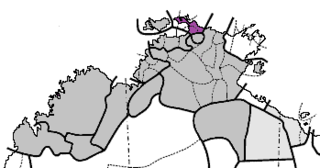
The Iwaidjan or Yiwaidjan languages are a small family of non-Pama–Nyungan Australian Aboriginal languages spoken in the Cobourg Peninsula region of Western Arnhem Land.

The Worrorran (Wororan) languages are a small family of Australian Aboriginal languages spoken in northern Western Australia.
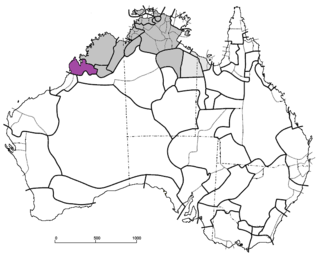
The Nyulnyulan languages are a small family of closely related Australian Aboriginal languages spoken in northern Western Australia. Most languages in this family are extinct, with only three extant languages, all of which are almost extinct.
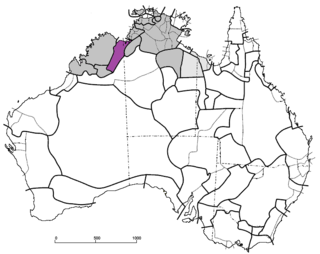
The Jarrakanlanguages are a small family of Australian Aboriginal languages spoken in northern Australia. The name is derived from the word jarrak, which means "language" in Kija.
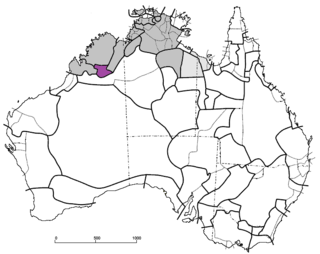
The Bunuban languages are a small family of Australian Aboriginal languages spoken in northern Australia. The family consists of two languages, Bunuba and Gooniyandi, which are related to each other to about the same degree that English is related to Dutch. Bunuba has about 100 speakers and Gooniyandi about 400. Both are endangered.
Kija is an Australian Aboriginal language today spoken by about 200 people, most of whom live in the region from Halls Creek to Kununurra and west to Lansdowne and Tableland Stations in Western Australia. It is a member of the Jarragan language family, a non-Pama-Nyungan family in the East Kimberleys. The Argyle Diamond Mine, on the south western corner of Lake Argyle is on the borders of Gija and Miriwoong country. The Purnululu Bungle Bungle National Park is mostly in Gija country.
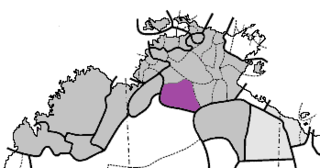
Wardaman is an Australian Aboriginal language isolate. It is one of the northern non-Pama–Nyungan languages. Dagoman and Yangman were either dialects or closely related languages; as a family, these are called Yangmanic.
Boiken is one of the more populous of the Ndu languages of Sepik River region of northern Papua New Guinea. It is spoken around Boiken Creek in Yangoru-Saussia District, East Sepik Province and adjacent islands off the north coast of northern Papua New Guinea.
Marranj is an Australian Aboriginal language, a dialect continuum consisting of Maranunggu, Menhthe, and Emmi.

Worrorra, also written Worora and other variants, and also known as Western Worrorran, is a moribund Australian Aboriginal language of northern Western Australia. It encompasses a number of dialects, which are spoken by a group of people known as the Worrorra people.
Gwari is a Nupoid language spoken by the Gbagyi people, which make up over a million people in Nigeria. There are two principal varieties, Gbari and Gbagyi, which have some difficulty in communication; sociolinguistically they are distinct languages.
Ayabadhu (Ayapathu), or Badhu, is an extinct Australian Aboriginal language of the Paman family spoken on the Cape York Peninsula of North Queensland, Australia by the Ayapathu people. The Ayabadhu language region includes the Cook Shire and the areas around Coen and Port Stewart.
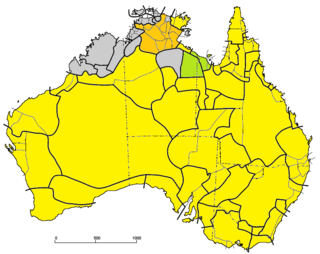
The Garawan languages (Garrwan), or Yanyi, are a small language family of Australian Aboriginal languages currently spoken in northern Australia.

The Macro-Gunwinyguan languages, also called Arnhem or Gunwinyguan, are a family of Australian Aboriginal languages spoken across eastern Arnhem Land in northern Australia. Their relationship has been demonstrated through shared morphology in their verbal inflections.
The Mati Ke, also known as the Magatige, are an Aboriginal Australian people, whose traditional lands are located in the Wadeye area in the Northern Territory. Their language is in danger of extinction, but there is a language revival project under way to preserve it.
The Wadjiginy, also referred to historically as the Wogait, are an indigenous Australian people of the Northern Territory, specifically from just north of modern-day Darwin. The Wadjiginy are a saltwater people who describe themselves as wagatj 'beach-dwellers' from the Batjamalh word wagatj 'beach'.
The Arnga are an Aboriginal Australian people of the northern Kimberley region of Western Australia.
The Yeidji, also spelt Yiiji and other variants, commonly known as Gwini/ Kwini, are an Aboriginal Australian people of the Kimberley area of Western Australia, who also self-identify as Balanggarra.
References
- 1 2 3 4 N31 Wadjiginy at the Australian Indigenous Languages Database, Australian Institute of Aboriginal and Torres Strait Islander Studies
- ↑ Ford, Lysbeth J. (1990). The phonology and morphology of Bachamal (Wogait). Canberra: Australian National University.
- ↑ Capell, Arthur (1940). "The Classification of Languages in North and North-west Australia". Oceania. 10 (3): 241–272. doi:10.1002/j.1834-4461.1940.tb00292.x. ISSN 1834-4461.